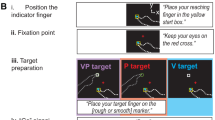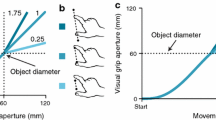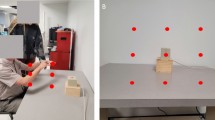Abstract
We examined the relative roles of visual and proprioceptive information about initial hand position on movement accuracy. A virtual reality environment was employed to dissociate visual information about hand position from the actual hand position. Previous studies examining the effects of such dissociations on perception of hand location have indicated a bias toward the visually displayed position. However, an earlier study, which employed optical prisms to dissociate visual and proprioceptive information prior to targeted movements, suggested a bias in movement direction toward that defined by the actual hand position. This implies that visual and proprioceptive information about hand position may be differentially employed for perceptual judgments and movement planning, respectively. We now employ a virtual reality environment to systematically manipulate the visual display of the hand start position from the actual hand position during movements made to a variety of directions. We asked whether subjects would adjust their movements in accord with the virtual or the actual hand location. Subjects performed a series of baseline movements toward one of three targets in each of three blocks of trials. Interspersed among these trials were "probe" trials in which the cursor location, but not the hand location, was displaced relative to the baseline start position. In all cases, cursor feedback was blanked at movement onset. Our findings indicated that subjects systematically adjusted the direction of movement in accord with the virtual, not the actual, start location of the hand. These findings support the hypothesis that visual information about hand position predominates in specifying movement direction.




Similar content being viewed by others
References
Atkeson CG, Hollerbach JM (1985) Kinematic features of unrestrained vertical arm movements. J Neurosci 5:2318–2330
DiZio P, Lathan CE, Lackner JR (1993) The role of brachial muscle spindle signals in assignment of visual direction. Journal of Neurophysiology 70:1578–1584
Favilla M, Hening W, Ghez C (1989) Trajectory control in targeted force impulses. VI. Independent specification of response amplitude and direction. Exp Brain Res 75:280–294
Fu QG, Suarez JI, Ebner TJ (1993) Neuronal specification of direction and distance during reaching movements in the superior precentral premotor area and primary motor cortex of monkeys. J Neurophysiol 70:2097–2116
Fu QG, Flament D, Coltz JD, Ebner TJ (1995) Temporal encoding of movement kinematics in the discharge of primate primary motor and premotor neurons. J Neurophysiol 73:836–854
Georgopoulos AP (1994) Population activity in the control of movement. Int Rev Neurobiol 37:103–119
Georgopoulos AP (1995) Current issues in directional motor control. Trends Neurosci 18:506–510
Georgopoulos AP (1996) Arm movements in monkeys: behavior and neurophysiology. J Comp Physiol [A] 179:603–612
Georgopoulos AP (2000) Neural aspects of cognitive motor control. Curr Opin Neurobiol 10:238–241
Ghez C, Hening W, Gordon J (1991) Organization of voluntary movement. Curr Opin Neurobiol 1:664–671
Ghez C, Favilla M, Ghilardi MF, Gordon J, Bermejo R, Pullman S (1997) Discrete and continuous planning of hand movements and isometric force trajectories. Exp Brain Res 115:217–233
Goodale MA, and Milner AD (1992) Separate visual pathways for perception and action. Trends Neurosci 15:20–25
Gordon J, Ghez C (1987a) Trajectory control in targeted force impulses. II. Pulse height control. Exp Brain Res 67:241–252
Gordon J, Ghez C (1987b) Trajectory control in targeted force impulses. III. Compensatory adjustments for initial errors. Exp Brain Res 67:253–269
Gordon J, Ghilardi MF, Cooper SE, Ghez C (1994a) Accuracy of planar reaching movements. II. Systematic extent errors resulting from inertial anisotropy. Exp Brain Res 99:112–130
Gordon J, Ghilardi MF, Ghez C (1994b) Accuracy of planar reaching movements. I. Independence of direction and extent variability. Exp Brain Res 99:97–111
Haffenden AM, Schiff KC, Goodale MA (2001) The dissociation between perception and action in the Ebbinghaus illusion: Nonillusory effects of pictorial cures on grasp. Curr Biol 11:177–181
Harris CS (1965) Perceptual adaptation to inverted, reversed, and displaced vision. Psychol Rev 72:419–444
Hay JC, Pick HL, Ikeda K (1965) Visual capture produced by prism spectacles. Pychon Sci 2:215–216
Juta AJ, van Beekum WT, Denier van der Gon JJ (1979) An attempt to quantify vibration induced movement sensation. J Physiol 292:18P
Kakei S, Hoffman DS, Strick PL (1999) Muscle and movement representations in the primary motor cortex. Science 285:2136–2139
Kalaska JF (1988) The representation of arm movements in postcentral and parietal cortex. Can J Physiol Pharmacol 66:455–463
Kalaska JF, Caminiti R, Georgopoulos AP (1983) Cortical mechanisms related to the direction of two-dimensional arm movements: relations in parietal area 5 and comparison with motor cortex. Exp Brain Res 51:247–260
Lackner JR, Levine MS (1979) Changes in apparent body orientation and sensory localization induced by vibration of postural muscles: vibratory myesthetic illusions. Aviat Space Environ Med 50:346–354
Messier J, Kalaska JF (2000) Covariation of primate dorsal premotor cell activity with direction and amplitude during a memorized-delay reaching task. J Neurophysiol 84:152–165
Oldfield RC (1971) The assessment and analysis of handedness: the Edinburgh inventory. Neuropsychologia 9:97–113
Pick HL, Warren DH, Hay JC (1969) Sensory conflict in judgments of spatial direction. Percept Psychophys 6:203–205
Rosenbaum DA (1980) Human movement initiation: specification of arm, direction, and extent. J Exp Psychol Gen 109:444–474
Rossetti Y, Desmerget M, Problanc C (1995) Vectorial coding of movement: vision, proprioception, or both? J Neurophysiol 74:457–463
Sainburg RL, Ghez C, Kalakanis D (1999) Intersegmental dynamics are controlled by sequential anticipatory, error correction, and postural mechanisms. J Neurophysiol 81:1045–1056
Sainburg RL, Lateiner JE, Latash ML, Bagesteiro LB (2003) Effects of altering initial position on movement direction and extent. J Neurophysiol 89:401–415
Van Beers RJ, Sittig AC, Denier van der Gon JJ (1996) How humans combine simultaneous proprioceptive and visual position information. Exp Brain Res 111:253–261
Van Beers RJ, Sittig AC, Denier van der Gon JJ (1999) Integration of proprioceptive and visual position-information: an experimentally supported model. J Neuroophysiol 81:1355–1364
Van Beers RJ, Wolpert DM, Haggard P (2002) When feeling is more important than seeing in sensorimotor adaptation. Curr Biol 14:12:834–837
Warren DH (1980) Response factors in intermodality localiztion under conflict conditions. Percept Psychophys 27:28–32
Warren DH, Cleaves WT (1971) Visual-proprioceptive interaction under large amounts of conflict. J Exp Psychol 90:206–214
Acknowledgements
The experiments in this paper were collected in partial fulfillment of Jordan Lateiner's master's thesis in the department of Kinesiology, The Pennsylvania State University. This research was supported by grant number HD39311 awarded by the National Center for Medical Rehabilitation Research of the National Institute of Child Health and Human Development.
Author information
Authors and Affiliations
Corresponding author
Rights and permissions
About this article
Cite this article
Lateiner, J.E., Sainburg, R.L. Differential contributions of vision and proprioception to movement accuracy. Exp Brain Res 151, 446–454 (2003). https://doi.org/10.1007/s00221-003-1503-8
Received:
Accepted:
Published:
Issue Date:
DOI: https://doi.org/10.1007/s00221-003-1503-8




